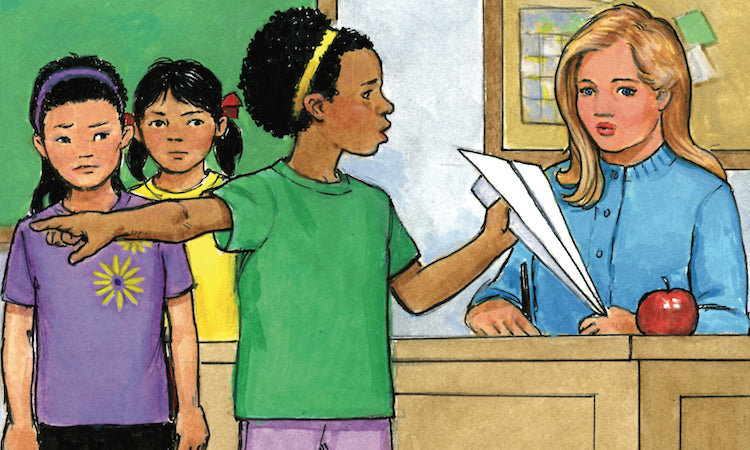By Cindy Price, First-Grade Teacher, Guest Blogger
This is the second part of a blog post series that shares ways to teach kids about bullying prevention as they read and write. In today's post, I'll describe how you can use a leveled book as an opportunity to practice oral language and share details of classroom activities you can plan for your classroom. If you missed the first part about engaging kids on the topic with a few ideas to use level H–I narrative texts for guided reading practice, you can read 5 Ways to Teach Kids About Bullying Prevention, Part 1 .
Create Opportunities for Oral Language Development Around a Book About Bullying
 Sophia and the Bully
is a level G fiction book for kids about a girl who starts a new school. She thinks she's bullied by a classmate, but she learns that he just wanted to be her friend. Some students may understand that certain actions can be mistaken for signs of bullying even though that's not the case.
Sophia and the Bully
is a level G fiction book for kids about a girl who starts a new school. She thinks she's bullied by a classmate, but she learns that he just wanted to be her friend. Some students may understand that certain actions can be mistaken for signs of bullying even though that's not the case.
This is a great book you can use to have a conversation with your students about how important it is to treat others nicely. To practice oral language development, have students choose a character and describe how they may be similar to that character. You can also encourage them to describe a time when any scene from the book also happened to them.
Use Classroom Activities That Facilitate Social-Emotional Development
There are so many ways to engage kids with activities during National Bullying Prevention Month because there's a ton of activities that focus on social-emotional learning and development. A focus wall is an excellent way to encourage each student in your class to possibly share their dreams and talents. This will help your students find peers who they may not have realized share interests.
Another meaningful activity I like to do is the wrinkled heart activity. This activity allows them to make real-world connections and to see the effects that words have on us and on others. Give each student a red paper heart. Ask them what do they think will happen to the heart in their body as they are spoken to in an unkind and bullying manner. This is also a good way to prompt kids to make inferences.
Have students write their ideas and then make a prediction about what will happen to the red paper heart. Have them keep their predictions to themselves. After a few moments, tell them that as you say a bully phrase or unkind words, they are to crumple their paper heart. Say three to five bully phrases or unkind statements. Then have them make a prediction about whether or not they can fix their hearts using kind words.
After they have made their predictions, tell students to smooth out their hearts when you say a kind statement. Now say three to five kind statements out loud. When students try to smooth the wrinkles out of their hearts, have them look at their hearts, and ask the following:
It is so important to provide our students with safe tools to identify, understand, and to stand up to bullying. Through interactive modeling, meaningful books for kids, role-playing, and a supportive classroom environment, we are able to provide our students with the knowledge they need to be a proponent of bullying prevention.
Please visit our blog soon for more ideas that will help your students flourish.
~~~
Cindy Price is a first-grade teacher from Delaware. If you like what you read here, take a look at her blog at Mrs. Price's Kindergators , and be sure to check back here for more of her guest blog posts!













































![6 Fun and Easy Activities to Practice Sequencing [Grades K-1]](http://www.hameraypublishing.com/cdn/shop/articles/Red_Typographic_Announcement_Twitter_Post-5_bf1ae163-a998-4503-aa03-555b038d1b76_600x.png?v=1689961568)
![Leveraging Prior Knowledge Before Writing and Reading Practice [Grades 1–2]](http://www.hameraypublishing.com/cdn/shop/articles/Red_Typographic_Announcement_Twitter_Post-4_600x.png?v=1689961965)




